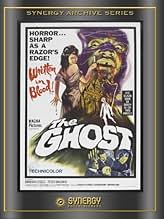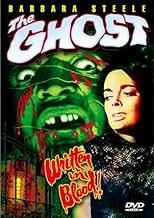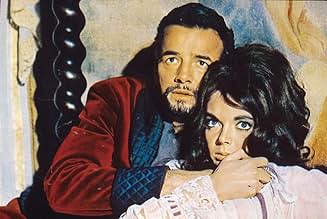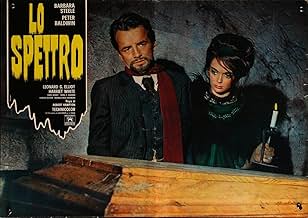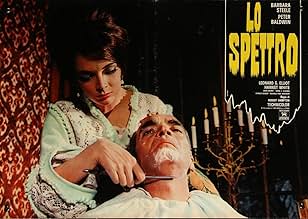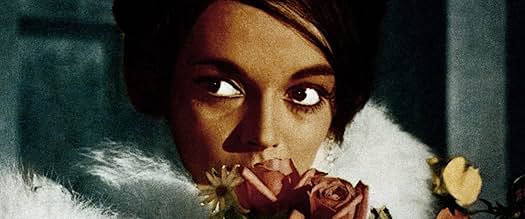ÉVALUATION IMDb
6,1/10
1,6 k
MA NOTE
Ajouter une intrigue dans votre langueA woman and her lover murder her doctor husband, but when strange things start happening, they wonder if they really killed him, or if he has come back from the dead to haunt them.A woman and her lover murder her doctor husband, but when strange things start happening, they wonder if they really killed him, or if he has come back from the dead to haunt them.A woman and her lover murder her doctor husband, but when strange things start happening, they wonder if they really killed him, or if he has come back from the dead to haunt them.
- Prix
- 1 nomination au total
Elio Jotta
- Dr. John Hichcock
- (as Leonard G. Elliot)
Harriet Medin
- Catherine Wood - Housekeeper
- (as Harriet White)
Carlo Kechler
- Police Superintendent
- (as Charles Kechler)
Umberto Raho
- Canon Owens
- (as Raoul H. Newman)
Avis en vedette
Riccardo Freda's "Lo Spettro" aka. "The Ghost" of 1963 is yet another delightfully uncanny Italian Gothic Horror film starring the wonderful Barbara Steele (my favorite actress), and while it cannot possibly compare to the absolute highlights in Steele's career, such as Mario Bava's masterpiece "La Maschera Del Demonio" ("Black Sunday", 1960), Roger Corman's "Pit and the Pendulum" (1961, also starring the great Vincent Price) or Antonio Margheriti's "Danza Macabra" ("Castle of Blood", 1964), this is another mesmerizing experience that no lover of Gothic greatness can afford to miss. "Lo Spettro" is a sequel to Freda's earlier Gothic Horror film, "L'Orribile Segreto Del Dr. Hichcock" ("The Horrible Dr. Hitchcock", 1962; they obviously left out a "t" in order to avoid legal difficulties), also starring Steele, which I haven't yet seen. Her character is named 'Margaret' in this film whereas the name was 'Cynthia' in "Dr. Hichcock. This film doesn't require having seen "Dr. Hichcock" , however.
Scotland, 1910: The brilliant, but critically ill, wheelchair-bound Dr. Hichcock (Elio Jotta), who needs to take lots of medications against his mysterious disease, is working on a serum to cure paralysis. His beautiful young wife Margaret (Barbara Steele) is having an affair with his assistant/colleague Dr. Livingstone (Peter Baldwin), however, and the two do not intend to wait for the old Doctor to pass away by natural reasons. Shortly after his funeral, creepy things begin to happen in the uncanny mansion...
As mentioned above, the ravishing Barbara Steele, is my favorite actress, and she is once again great here. In my humble opinion, no other actress was ever capable of blending incomparable beauty with a genius for the uncanny as it is the case with this unchallenged Goddess of Gothic Horror, and no other actress ever will. Under the solid direction of Riccardo Freda, Miss Steele plays yet another typical role with typical greatness. As the credited director of the first (post-WW2) Italian Horror film, "I Vampiri" of 1957, Freda deserves praise as one of the pioneers of Italian Horror, though it must be said that it was actually the great Mario Bava (my choice for the greatest Horror director of all-time) who completed that gem and who is arguably responsible for its greatness. Besides our beloved Barbara, the rest of the cast is also very good, especially Elio Jotta is great as the sinister Dr. Hichcock. William Baldwin is good enough as Dr. Livingstone, as is Harriet Medin as the housekeeper, and the cast furthermore includes Umberto Raho, whom Italian Horror fans might recognize as a regular supporting actor in many films (including Margheriti's "Castle of Blood", Bava's "Baron Blood" and Ubaldo Ragona's "The Last Man on Earth" starring Vincent Price).
The film is almost entirely set inside Dr. Hichcocks eerie, castle-like mansion, which is a terrific setting for old-fashioned Goth-Horror indeed. Franco Mannino's score, which mainly consists of an eerily beautiful theme that is replayed throughout the film, greatly increases the film's rich atmosphere. Overall, "Lo Spettro" is not one of the greatest films in Barbara Steele's filmography, but it still is a very good and creepy Gothic Horror film that none of her fans could possibly afford to miss. Barbara Steele is once again stunningly beautiful, and brilliantly sinister - I simply cannot find enough words to adequately praise this wonderful lady. Barbara, we worship you!
Scotland, 1910: The brilliant, but critically ill, wheelchair-bound Dr. Hichcock (Elio Jotta), who needs to take lots of medications against his mysterious disease, is working on a serum to cure paralysis. His beautiful young wife Margaret (Barbara Steele) is having an affair with his assistant/colleague Dr. Livingstone (Peter Baldwin), however, and the two do not intend to wait for the old Doctor to pass away by natural reasons. Shortly after his funeral, creepy things begin to happen in the uncanny mansion...
As mentioned above, the ravishing Barbara Steele, is my favorite actress, and she is once again great here. In my humble opinion, no other actress was ever capable of blending incomparable beauty with a genius for the uncanny as it is the case with this unchallenged Goddess of Gothic Horror, and no other actress ever will. Under the solid direction of Riccardo Freda, Miss Steele plays yet another typical role with typical greatness. As the credited director of the first (post-WW2) Italian Horror film, "I Vampiri" of 1957, Freda deserves praise as one of the pioneers of Italian Horror, though it must be said that it was actually the great Mario Bava (my choice for the greatest Horror director of all-time) who completed that gem and who is arguably responsible for its greatness. Besides our beloved Barbara, the rest of the cast is also very good, especially Elio Jotta is great as the sinister Dr. Hichcock. William Baldwin is good enough as Dr. Livingstone, as is Harriet Medin as the housekeeper, and the cast furthermore includes Umberto Raho, whom Italian Horror fans might recognize as a regular supporting actor in many films (including Margheriti's "Castle of Blood", Bava's "Baron Blood" and Ubaldo Ragona's "The Last Man on Earth" starring Vincent Price).
The film is almost entirely set inside Dr. Hichcocks eerie, castle-like mansion, which is a terrific setting for old-fashioned Goth-Horror indeed. Franco Mannino's score, which mainly consists of an eerily beautiful theme that is replayed throughout the film, greatly increases the film's rich atmosphere. Overall, "Lo Spettro" is not one of the greatest films in Barbara Steele's filmography, but it still is a very good and creepy Gothic Horror film that none of her fans could possibly afford to miss. Barbara Steele is once again stunningly beautiful, and brilliantly sinister - I simply cannot find enough words to adequately praise this wonderful lady. Barbara, we worship you!
As you might expect, this film is really quite similar to Riccardo Freda's earlier horror flick "The Terror of Dr Hitchcock", although for my money; I'd say this one is slightly better. The two films share a director and a lead actress in common, as well as a lead character name. This film firmly fits into the 'Gothic' side of Italian cinema, which Steele often starred in, and Freda makes excellent use of this style with some real standout cinematography. It became clear that Riccardo Freda was, in fact, a hack; as it turned out that the great Mario Bava did most of the work on a lot of his films, and his later stuff - Tragic Ceremony and The Iguana with the Tongue of Fire to name a couple - was a million miles away from being brilliant. This film would appear to be Freda at his best, therefore, and it's actually not bad. The plot centres on Dr. John Hitchcock; a cripple who wants to die. His wife is, naturally, having an affair with her husband's doctor, and pretty soon the two of them conspire to murder Dr Hitchcock for his money. However, they didn't bargain for him haunting them after his death...
The film's title suggests that it's a ghost story, but I would say that The Ghost is more of a mystery chiller. There's not a great deal of real bona fide horror, and to be honest; I felt the film was a little too talky and would have proffered it to be a bit more visceral. The film's main draw is, obviously, Barbara Steele and the 'Queen of Horror' looks great throughout the film. The decor and set design is great too, and these allow Freda to build an oppressive and macabre atmosphere, which benefits the plot line quite well. The main problem with the film is the fact that a lot of it feels really amateurish. The dubbing is atrocious (even more so than usual) and some of the things the characters say are ridiculous. Whether or not that's down to the translation, I don't know. The climax is the best part of the film for me. Of course, it's not a completely sense-making ending and there are a few holes left; but it's a nice twist at least, and it does justify the shortfalls of some of the rest of the movie. Overall, I won't go as far as to say that The Ghost is a horror classic; but it's good entertainment, and fans of Gothic horror will enjoy it.
The film's title suggests that it's a ghost story, but I would say that The Ghost is more of a mystery chiller. There's not a great deal of real bona fide horror, and to be honest; I felt the film was a little too talky and would have proffered it to be a bit more visceral. The film's main draw is, obviously, Barbara Steele and the 'Queen of Horror' looks great throughout the film. The decor and set design is great too, and these allow Freda to build an oppressive and macabre atmosphere, which benefits the plot line quite well. The main problem with the film is the fact that a lot of it feels really amateurish. The dubbing is atrocious (even more so than usual) and some of the things the characters say are ridiculous. Whether or not that's down to the translation, I don't know. The climax is the best part of the film for me. Of course, it's not a completely sense-making ending and there are a few holes left; but it's a nice twist at least, and it does justify the shortfalls of some of the rest of the movie. Overall, I won't go as far as to say that The Ghost is a horror classic; but it's good entertainment, and fans of Gothic horror will enjoy it.
This film perhaps holds up better than the first Dr. Hitchcock film and can be seen with or without that film. It stands on its own. A good film for people to be introduced to director Freda's work with. It gets better with repeated viewings and the music score is very good. This is not, just as none of his films are, a supernatural movie. So just know that going in. The film still has a good Gothic feel to it. Sadly there is no really good DVD release version of the film. There is a key and very graphic murder scene that is either cut down or cut completely out of several versions available. Without that being intact the impact of the later part of the film is really reduced. Think about Psycho if you basically cut out the shower scene. Not that this is in Psycho's league but this scene I'm talking about really makes this film work. It would be nice if Freda's films got a box set release of proper versions of his film. He started Mario Bava's career and Argento says Freda had more of an influence on him than Bava was. For now you have to really look hard and watch pretty lousy versions of his films to try to discover him as a director. It's worth the effort but would be nice for him to get some decent releases.
Riccardo Freda, an Italian director of skill who directed many Sword and Sandal films of the 60's as well as horror greats like I Vampiri, does a very serviceable job directing this thoughtful, mood-laden sequel of sorts to his earlier effort The Horrible Doctor Hitchcok. One does not need to have seen that earlier effort to follow what goes on here as they are really entities unto themselves with the same characters just going through different circumstances and having different motivations. In this film Dr. Hitchcock(living in Scotland - very implausible given the Mediterranean looks of most of the cast) is bound in a wheelchair and has nothing but sickly pity for himself as he wishes to die. Helping him remain alive is a local doctor giving him some sort of concoction to live and, of course, no love triangle would be complete without the love object of the other two sides - sultry, hypnotic breathless Barbara Steele - the 60's queen of the horror film - particularly the Gothic horror film. Steele is not a great actress by any stretch. She is lovely to look at and has the most impressive pair of - yes, I know where I could go here but really I intended to say eyes the entire time. Freda creates a slowly building tension between the central characters and the story is nothing exceptional in terms of creativity. You have seen this story before in various adaptations. Freda does; however, have a flair with the camera lens, and I was really surprised at how well he, the actors, and the story all combined to make an interesting film experience. The rest of the cast is all serviceable with Elio Jotta as Dr. Hitchcock being particularly effective and Harriet Medin(who was in the previous Hitchcock film also as a maid) doing a nice, creepy job as Catherine the housemaid. There are some very powerfully shot scenes: the tomb scene is genuinely eerie and the final denouement is quite good. Loads of atmosphere make this one of the best of its kind.
This highly-regarded example of the Italian Gothic Horror style had eluded me until now; even so, having caught up with it at long last, I still wasn't done with the 'Curse Of THE GHOST': the Retromedia DVD proved faulty, with a glitch around the one-hour mark (where the image skipped and the audio dropped out) and then experienced complete freezing after 88 minutes - so much so that I had to finish the film off on another player! This was after a public domain copy I rented from Hollywood when I was there in late 2005 (which, on a hunch, I decided to check before watching) reverted to the Main Menu midway through the climax!!
Anyway, the film itself is undeniably a highlight of the genre and one of Freda's best (which he made in just 12 days): a follow-up, not a sequel, to his previous collaboration with star Barbara Steele - THE HORRIBLE DR. HICHCOCK (1962) - despite the re-use of that notorious character's surname. In the earlier film, too, Steele had been overshadowed by a delightfully manic turn from Robert Flemyng but, here, she lives up to her iconic status as the Queen Of Gothic Horror: few actresses have managed to replicate her sensual mix of wickedness and vulnerability; as for the actor playing Hichcock this time around, who looks a bit like Howard Vernon, he's not too bad - if no match, ultimately, for Flemyng.
Like I said with respect to Hammer's FEAR IN THE NIGHT (1972), the plot twists aren't very original - but they make for a great ride regardless; besides, one could just soak in the colorful visuals (even if the print involved features a lot of wear and tear!). Incidentally, the film is rather gory for its time (witness the 'ghost' exhibiting its decaying flesh and the brutal razor murder, with its wonderful device of having blood dripping across the camera lens to simulate the victim's POV), but the lush score (actually a collection of compositions by Francesco De Masi, Franco Mannino and Roman Vlad - billed under one Americanized name, Franck Wallace!) and a reasonable quota of chills (the creepy scenes where the doctor speaks through his faithful and vaguely sinister housekeeper - played by the ubiquitous Harriet White Medin - who, conveniently, doubles as a medium and the various 'apparitions' - wheelchair stumbling down the stairs, dangling corpse) are certainly par for the course...as is, after all, the film's decidedly languid pace.
The deftly ironic climax is very effective - as a self-satisfied Hichcock expounds on his clever machinations while the immobilized Steele looks horridly on, fully knowing that she'll be blamed for the housekeeper's death and, worse still, that she killed her lover for no reason (i.e. he didn't betray her by stealing the jewels, as she had mistakenly assumed, and these were now once more in Hichcock's hands). The English dubbing isn't too bad considering; however, given the story's Scottish setting, it's odd that only one voice actor would deem it fit to attempt a pertinent accent (i.e. the solicitor who reads Dr. Hichcock's will) - which then causes it to seem unintentionally amusing alongside the less heavy inflections of his fellow dubbing artists!
While Freda is often accused of being indifferent to his films (which he often did purely so as to recoup his gambling losses!), he was undoubtedly a pioneer: not only making the first Italian horror effort, but his masterful use of color in the Dr. Hichcock pictures certainly pushed the genre into that corner - after a solitary stab at it by Giorgio Ferroni in MILL OF THE STONE WOMEN (1960) - as few gothics were shot in black-and-white thereafter (notably three films featuring Steele herself, namely CASTLE OF BLOOD [1964], THE LONG HAIR OF DEATH [1964] and NIGHTMARE CASTLE aka THE FACELESS MONSTER [1965]); certainly, Freda's protégé Mario Bava followed his example...and gradually took over the genre!
Anyway, the film itself is undeniably a highlight of the genre and one of Freda's best (which he made in just 12 days): a follow-up, not a sequel, to his previous collaboration with star Barbara Steele - THE HORRIBLE DR. HICHCOCK (1962) - despite the re-use of that notorious character's surname. In the earlier film, too, Steele had been overshadowed by a delightfully manic turn from Robert Flemyng but, here, she lives up to her iconic status as the Queen Of Gothic Horror: few actresses have managed to replicate her sensual mix of wickedness and vulnerability; as for the actor playing Hichcock this time around, who looks a bit like Howard Vernon, he's not too bad - if no match, ultimately, for Flemyng.
Like I said with respect to Hammer's FEAR IN THE NIGHT (1972), the plot twists aren't very original - but they make for a great ride regardless; besides, one could just soak in the colorful visuals (even if the print involved features a lot of wear and tear!). Incidentally, the film is rather gory for its time (witness the 'ghost' exhibiting its decaying flesh and the brutal razor murder, with its wonderful device of having blood dripping across the camera lens to simulate the victim's POV), but the lush score (actually a collection of compositions by Francesco De Masi, Franco Mannino and Roman Vlad - billed under one Americanized name, Franck Wallace!) and a reasonable quota of chills (the creepy scenes where the doctor speaks through his faithful and vaguely sinister housekeeper - played by the ubiquitous Harriet White Medin - who, conveniently, doubles as a medium and the various 'apparitions' - wheelchair stumbling down the stairs, dangling corpse) are certainly par for the course...as is, after all, the film's decidedly languid pace.
The deftly ironic climax is very effective - as a self-satisfied Hichcock expounds on his clever machinations while the immobilized Steele looks horridly on, fully knowing that she'll be blamed for the housekeeper's death and, worse still, that she killed her lover for no reason (i.e. he didn't betray her by stealing the jewels, as she had mistakenly assumed, and these were now once more in Hichcock's hands). The English dubbing isn't too bad considering; however, given the story's Scottish setting, it's odd that only one voice actor would deem it fit to attempt a pertinent accent (i.e. the solicitor who reads Dr. Hichcock's will) - which then causes it to seem unintentionally amusing alongside the less heavy inflections of his fellow dubbing artists!
While Freda is often accused of being indifferent to his films (which he often did purely so as to recoup his gambling losses!), he was undoubtedly a pioneer: not only making the first Italian horror effort, but his masterful use of color in the Dr. Hichcock pictures certainly pushed the genre into that corner - after a solitary stab at it by Giorgio Ferroni in MILL OF THE STONE WOMEN (1960) - as few gothics were shot in black-and-white thereafter (notably three films featuring Steele herself, namely CASTLE OF BLOOD [1964], THE LONG HAIR OF DEATH [1964] and NIGHTMARE CASTLE aka THE FACELESS MONSTER [1965]); certainly, Freda's protégé Mario Bava followed his example...and gradually took over the genre!
Le saviez-vous
- AnecdotesMade during the pseudonym craze of the 1960s, the music score was credited to "Franck Wallace." Italian composers usually registered their pseudonyms with their performing right society, the SIAE, and the identities were listed by Bianco e Nero and the Monthly Film Bulletin who both reported that Wallace was Franco Mannino. However, some reference sources such as Donald C. Willis in 1972 suggested "Franck Wallace" was a joint pseudonym for Mannino and Roman Vlad (the two composers sometimes collaborated and Wallace is a very rough transliteration of Vlad). Even more confusingly, Beat Records released the soundtrack in 2008 and discovered that the surviving tapes in the Nazionalmusic vaults were attributed to Francesco De Masi. So the CD went out credited to De Masi only. De Masi did not work with either of the other two composers, instead being asked at the behest of the director to do a new score, not liking Mannino's effort; what portions thereof are contained in the film, are unknown, as the director seemingly changed his mind again, as Mannino is credited in the film for the score.
- GaffesWhen Dr. Livingston removes the bullet from the wall, there is a close-up of him holding an entire cartridge in his hands.
- Citations
Dr. John Hichcock: [hands around Margaret's throat] Feel how strong my grip is? But I won't kill you.
- ConnexionsFeatured in 100 Years of Horror: Ghosts (1996)
Meilleurs choix
Connectez-vous pour évaluer et surveiller les recommandations personnalisées
- How long is The Ghost?Propulsé par Alexa
Détails
- Durée1 heure 37 minutes
- Mixage
- Rapport de forme
- 1.85 : 1
Contribuer à cette page
Suggérer une modification ou ajouter du contenu manquant

Lacune principale
By what name was Le Spectre du Professeur Hitchcock (1963) officially released in India in English?
Répondre
